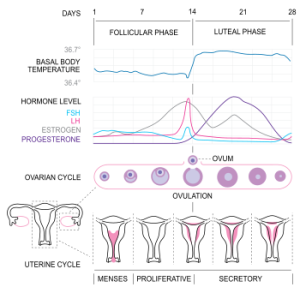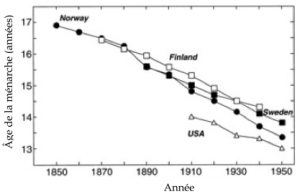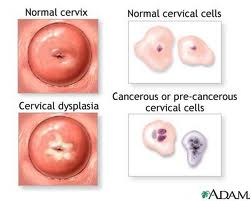
Estrogen is one of the two major hormones that a women produces; progesterone is the other. With all the environmental estrogen that mimics the effects of natural estrogen, women are starting to gain excessive amounts of estrogen, a condition called estrogen dominance. Estrogen dominance is a condition where woman can have deficient, normal, or excessive estrogen. In the case of environmental estrogen, we are seeing excessive amounts [15]. Some people may think that having “extra” estrogen is not bad for women, since estrogen is the major female hormone, released under normal conditions from female germ cells. Actually, that excessive amount of estrogen can have adverse effects on women by causing an offset of progesterone. In the body, there exists a very delicate balance between these two hormones.
In women, estrogen and progesterone help prepare a woman’s reproductive tract for fertilization. If fertilization does not take place, the preparation that is done will leave the woman’s system. This whole process is known as menstrual period. The menstrual cycle last approximately 28 days. During the first 14 days, estrogen levels will rise. Estrogen’s job is to cause thickening of the lining of the uterus and change the cervical mucous for preparation of pregnancy. Once the 14 days is up, ovulation will take place. During that time, estrogen levels will decrease. The next 14 days, progesterone levels will rise. The job of progesterone is to cause the endometrium to be thick with mucous, as well as, keeping the uterus from contracting. If fertilization does not occur progesterone will rid the uterus of the endometrium lining and unfertilized egg [19].
Thus, it is essential that these two hormones stay balanced with one another. If the excessive estrogen from the environment causes imbalanced levels, then this can lead to having the menstrual cycle thrown off in timing, or potentially cause infertility. The symptoms that go along with imbalanced levels can be fatigue, weight gain, mood swings and more [16].
 Not only can estrogen dominance interfere with the menstrual cycle, but it can cause early menstruation in young girls. These days children are being exposed to so many environmental estrogens through food and unhealthy lifestyles. That the average age for menstruation in young girls has substantially decreased. From the excessive amounts of estrogens, younger girls are starting their menarche earlier because their bodies are gaining estrogen faster than normal [10]. Below is a graph of America with two other countries, showing the average age of the onset of menses occuring in girls. A significant decrease can be seen in the 100 years between 1850 and 1950 and the decrease is becoming worse and worse as our society develops more and more. Further information is provided in the “Effects on Puberty” section.
Not only can estrogen dominance interfere with the menstrual cycle, but it can cause early menstruation in young girls. These days children are being exposed to so many environmental estrogens through food and unhealthy lifestyles. That the average age for menstruation in young girls has substantially decreased. From the excessive amounts of estrogens, younger girls are starting their menarche earlier because their bodies are gaining estrogen faster than normal [10]. Below is a graph of America with two other countries, showing the average age of the onset of menses occuring in girls. A significant decrease can be seen in the 100 years between 1850 and 1950 and the decrease is becoming worse and worse as our society develops more and more. Further information is provided in the “Effects on Puberty” section.
 Estrogen dominance is a common condition for woman, due to environmental estrogen. There are many symptoms and conditions that go along with estrogen dominance. For instance, cervical dysplasia is a condition caused by interference of estrogen. Cervical dysplasia is the abnormal appearance of the cells on the surface of the cervix. This is considered a precancerous condition [18]. Typically cervical dysplasia is associated with HPV (human papilloma virus), but nutrients also play a role in cervical dysplasia. If a woman’s diet consists of nutrients that can contain environmental estrogen such as treated fruits and vegetables then cervical dysplasia could occur.
Estrogen dominance is a common condition for woman, due to environmental estrogen. There are many symptoms and conditions that go along with estrogen dominance. For instance, cervical dysplasia is a condition caused by interference of estrogen. Cervical dysplasia is the abnormal appearance of the cells on the surface of the cervix. This is considered a precancerous condition [18]. Typically cervical dysplasia is associated with HPV (human papilloma virus), but nutrients also play a role in cervical dysplasia. If a woman’s diet consists of nutrients that can contain environmental estrogen such as treated fruits and vegetables then cervical dysplasia could occur.
Other conditions that can arise from estrogen dominance are be breast cancer, thyroid dysfunction mimicking hypothyroidism, endometrial (uterine) cancer, fibrocystic breasts, polycystic ovaries, premenopausal bone loss, blood clotting and many other severe conditions [17].
So where can people get estrogen dominance? Almost anywhere that these foreign estrogens are present. In fact, it is possible that everyone is suffering from a little of environmental estrogen, especially if they live in a well-developed country. Read further about how can you prevent the release of environmental estrogen in our “How to Reduce Your Risk” page. This might make you want to change your lifestyle, depending how healthy your lifestyle is.

Leave a comment